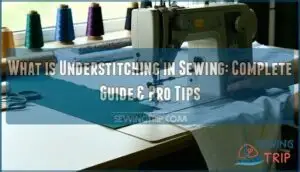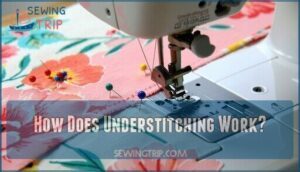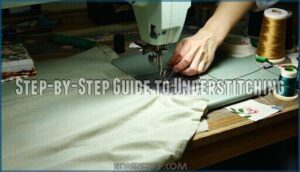This site is supported by our readers. We may earn a commission, at no cost to you, if you purchase through links.

It’s commonly used on necklines, armholes, and waistbands to create that crisp, professional finish that makes your handmade pieces look store-bought. Unlike topstitching, which decorates the garment’s surface, understitching works invisibly to secure edges. The technique transforms amateur-looking projects into polished, ready-to-wear pieces that stay put through countless wears and washes.
Table Of Contents
Key Takeaways
- You’ll create professional-looking garments by stitching seam allowances to facings or linings, preventing them from rolling outward and showing on your garment’s right side.
- Focus on necklines, armholes, and waistbands where this technique works best to keep facings hidden and create crisp, polished edges that withstand washing and wear.
- Press seam allowances toward the facing first, then stitch 1/8 to 1/4 inch from the original seam line through the facing and seam allowances only—never the main fabric.
- You can hand-stitch for delicate fabrics or use alternatives like topstitching when understitching isn’t suitable, but don’t skip it entirely if you want that store-bought finish.
What is Understitching in Sewing?
If you’ve ever wondered why some garments look effortlessly polished while others seem a bit unfinished, understitching might be the secret you’re missing.
This simple technique keeps facings and linings exactly where they belong – hidden on the inside – creating that crisp, professional finish that separates homemade from handmade.
Understitching transforms amateur sewing into professional-grade garments with one hidden stitch
Definition and Purpose
Understanching is a foundational sewing technique where you stitch the seam allowance to the facing or lining, keeping it hidden inside your garment.
This professional technique prevents facings from peeking out and creates crisp, polished edges on necklines, armholes, and waistbands.
It’s your secret weapon for achieving that coveted ready-to-wear finish in garment construction.
How Understitching Differs From Topstitching
While understitching hides on the wrong side, topstitching shows proudly on the right side of your garment.
Think of topstitching as the showoff—it adds decorative flair and seam security you can see.
Understitching works behind the scenes, keeping facings and linings behaved without affecting your garment’s appearance.
Different sewing techniques, different jobs entirely, with seam security being a key aspect.
Key Benefits for Garment Construction
Professional benefits of understitching sewing make it worth mastering.
You’ll achieve garment stability by securing seam allowances, preventing facings from rolling outward.
This sewing technique provides seam security that withstands washing and wear.
Your fabric selection matters less when understitching creates structure.
These construction tips guarantee a professional finish that rivals store-bought clothing, transforming homemade garments into polished pieces through proper garment finishing and seam finishing techniques.
Mastering the seam allowance techniques is vital for a successful understitching process.
How Does Understitching Work?
Now that you understand what understitching is, let’s explore how this technique actually works in practice.
You’ll discover where to apply understitching on your garments and how it transforms those tricky seam allowances into perfectly behaved edges that stay put, utilizing the understitching technique.
Where Understitching is Used on Garments
You’ll find understitching working behind the scenes in several key garment areas.
This sewing technique keeps facings and linings perfectly hidden while creating professional-looking finishes:
- Neckline Applications – Prevents facings from peeking out on V-necks and round necklines
- Armhole Stability – Keeps sleeveless tops and dress armholes flat and secure
- Waistband Finishes – Maintains clean edges on skirts and pants waistbands
- Jacket Linings – Secures front openings and collar facings in custom-made pieces
- Childrenswear Durability – Creates lasting, wash-friendly seam allowances that won’t shift
It is considered a basic sewing technique for achieving professional results.
The Role of Seam Allowance and Lining
Your seam allowance width directly impacts understitching success—aim for 1/8 to 1/4 inch depending on fabric thickness.
The right seam allowance width makes understitching work like magic—too narrow and it won’t hold, too wide and it creates bulk
The lining fabric choice matters too; lightweight materials work best for reducing bulk.
When securing seam allowance to the lining, you’re creating layer stability that prevents facings from peeking out.
This sewing technique transforms wobbly edges into crisp, professional-looking seams.
Common Areas for Understitching (Necklines, Armholes, Waistbands)
You’ll find understitching most commonly on three key areas: necklines, armholes, and waistbands.
These spots are where facings love to peek out and ruin your hard work.
Different neckline shapes and curve challenges require this sewing technique to keep the lining side behaving properly.
Armhole finishes especially benefit from understitching since they get lots of movement and stress during wear.
Step-by-Step Guide to Understitching
Now you’ve got the basics down, let’s walk through the actual process step by step. You’ll find that understitching becomes second nature once you practice these four key stages a few times.
Preparing The Seam and Materials
Now you’ll begin the hands-on work that transforms ordinary seams into polished perfection. Start by sewing your fabric pieces right sides together using your pattern’s specified seam allowance.
Next comes the game-changer: pressing that seam allowance toward the lining or facing. This Seam Allowance Prep sets you up for success.
Heat up your iron for heavier fabric, but gentle finger manipulation works better for stretchy materials. To confirm stability, consider checking grain lines before sewing.
The seam allowance should stay put against the lining, visible and ready for your understitching tutorial magic.
Clipping and Notching for Curved Seams
Curved seams need special attention before understitching.
For concave curves (like necklines), make straight clips perpendicular to the seam allowances, stopping just before the stitching line.
For convex curves (like armholes), cut small triangular notches to remove bulk.
These techniques help fabric types lay flat and prevent puckering during the understitching process.
Executing The Understitch With a Sewing Machine
Now you’re ready to fire up your sewing machine for understitching! Set your stitch length to 2.5-3.5mm and position the lining to your needle’s right.
Understitching helps in preventing lining roll on garments.
Adjust needle position or use your presser foot edge as a guide, stitching 1/8" from the seam line.
Keep seam tautness by gently pulling fabric layers apart while maintaining proper tension adjustment—this prevents slipping and catches those seam allowances perfectly underneath your lining.
Finishing and Pressing for a Professional Look
Your final pressing technique is the make-or-break moment that transforms good understitching into a professional finish. This vital step requires attention to detail and proper technique.
- Seam Allowance Control – Press the understitched seam flat, guaranteeing the seam allowance stays anchored to the lining without shifting or bunching.
- Pressing Techniques – Use steam and gentle pressure to roll the seam slightly toward the wrong side, hiding any visible stitching lines from the right side.
- Fabric Considerations – Adjust heat settings based on your fabric type, using a pressing cloth for delicate materials to prevent shine or damage. For ideal results, consider using a specialized pressing cloth.
- Tool Selection – Choose between an iron for crisp edges on structured fabrics or finger-pressing for lightweight materials that might pucker under heat.
- Final Inspection – Check from both sides to guarantee the lining lies flat against the garment with no peeking edges or visible understitching.
Tips and Best Practices for Understitching
Mastering understitching requires attention to detail, but a few key techniques will transform your sewing from amateur to professional.
These proven methods guarantee consistent results while saving time and preventing common frustrations that can make even experienced sewers want to throw their projects across the room, ultimately leading to a more professional outcome.
Maintaining Consistent Seam Allowance
Consistency makes all the difference when understitching – think of it as your sewing GPS. You’ll want to maintain a steady seam allowance width between 1/8 and 1/4 inch from your original seam line, adjusting for fabric thickness and bulk management needs.
| Fabric Type | Seam Allowance Width | Adjustment Tips |
|---|---|---|
| Lightweight cotton | 1/8 inch (3mm) | Use standard needle position |
| Medium weight denim | 3/16 inch (5mm) | Account for extra bulk |
| Heavy wool | 1/4 inch (6mm) | Wider allowance prevents puckering |
| Stretchy knits | 1/8 inch (3mm) | Keep fabric taut while sewing |
| Delicate silk | 1/16 inch (1.5mm) | Hand basting helps control |
Your understitching should create parallel sewing stitches that stay equidistant from the seam throughout the entire process. This foundational sewing technique for beginners requires patience but delivers professional results every time.
Using Presser Foot or Needle Position for Guidance
Your presser foot becomes your trusty guide for straight seam techniques when understitching.
Position your needle 2-3mm from the original seam, using the presser foot ridge as your reference point. For consistent stitching, adjust your needle position rather than eyeballing the distance.
This prevents wobbly lines and keeps your seam allowance perfectly aligned, avoiding ridges that scream "beginner mistake.
Many sewers find foot attachments helpful for improving their understitching techniques.
Handling Different Fabrics and Bulk
Fabric types bring unique challenges when understitching—heavy wools need wider seam allowances, while delicate silks require gentle handling.
Bulk reduction starts with seam grading: trim interfaced fabrics narrower than the lining to prevent ridges showing through.
Layer manipulation matters too—press seam allowances toward the facing before understitching, using your iron for thick materials or fingers for stretchy ones.
Hand Understitching for Delicate Garments
When machine sewing becomes too bulky for delicate fabric, hand understitching offers precise control.
Choose a sharp needle and matching thread for your lining.
Create tiny pick-stitches through the seam allowance and facing only, avoiding the main fabric.
Keep tension light to prevent puckering.
This sewing technique works beautifully on silk, chiffon, or fine wool where machine stitching might damage fibers.
Secure threads with small knots hidden within the seam allowance for invisible finishing and to ensure a clean look with precise control.
When to Use or Skip Understitching
Knowing when to use understitching versus when you can skip it will save you time and improve your sewing results.
You’ll want to take into account your fabric type, the garment’s structure, and how much time you’re willing to invest in finishing details.
Alternatives to Understitching
Several alternatives work well when understitching isn’t suitable for your project. Bias tape offers excellent control on curves, while topstitching benefits include visible reinforcement and decorative appeal. Serged edges prevent fraying effectively.
Many prefer using zigzag stitch techniques as well.
- Bias tape: Perfect for curved necklines and armholes, providing clean fabric finishing without bulk
- Topstitching: Creates visible reinforcement while securing seam allowance and lining in place
- Blind stitch: Invisible hand-sewn option that mimics understitching results through careful ironing and stitching
Patterns and Projects That Benefit Most
Mastering dress patterns with fitted bodices and childrenswear requires strategic understitching placement. You’ll find this technique essential for custom collars, jacket linings, and any facing that threatens to peek out.
| Project Type | Key Areas | Why It Matters |
|---|---|---|
| Dress Patterns | Necklines, armholes | Prevents lining roll on curved edges |
| Jacket Linings | Lapels, front facings | Keeps interior layers hidden |
| Childrenswear | All openings | Withstands active play and washing |
Home decor projects with structured edges also benefit from this seam allowance technique for professional sewing details.
Common Mistakes and How to Avoid Them
While rushing through understitching can lead to frustration, avoiding these common pitfalls will save you time and heartache.
Poor pressing before stitching creates fabric shifting, while inconsistent seam allowance causes uneven stitching.
- Fabric Shifting: Press seam allowances toward lining first, then pin if needed
- Uneven Stitching: Use presser foot edge or needle position guides for consistency
- Tunneling Seams: Don’t pull fabric too tight while sewing—gentle tension works
- Missed Seam: Check that you’re catching all seam allowance layers before finishing
Frequently Asked Questions (FAQs)
Are there any alternative techniques to understitching for securing facings and linings?
Yes, you can use several alternatives: topstitching (visible stitching on the garment’s right side), hand-basting the facing in place, using fusible interfacing to bond layers, or simply pressing and steaming facings flat for lighter fabrics.
Can understitching be done by hand instead?
You can absolutely hand-stitch understitching! Use a running stitch or backstitch about 1/8 inch from the seam line. It’s slower but gives you perfect control, especially for delicate fabrics or curves.
What needle size works best for understitching?
Don’t worry about overthinking needle choices – your regular universal needle likely works fine.
Use a 70/10 or 80/12 universal needle for most fabrics, adjusting up for heavier materials or down for delicates.
Does understitching work on all fabric types?
Understitching works well on most fabrics, but you’ll need to adjust your technique.
Heavy fabrics like denim require longer stitches and careful pressing, while delicate fabrics need gentler handling and sometimes hand-stitching for best results.
Can you understitch without grading seam allowances?
You can absolutely understitch without grading seam allowances, though grading reduces bulk for a cleaner finish.
The understitch will still secure seam allowances to the facing, preventing roll-out and maintaining structure, as it is a method that can be used to prevent roll-out.
Should understitching thread match the facing color?
Matching your thread to the facing color is a smart move—it keeps stitches hidden on the inside.
If you’ve ever had your lining peek out, you know it’s like socks with sandals—best kept subtle!
What happens if you skip understitching entirely?
Perfect seams versus wonky edges—that’s the difference skipping understitching makes. Without it, your facings will peek out stubbornly, creating an unprofessional look that screams homemade rather than handmade perfection.
Can you understitch before attaching the facing?
No, you can’t understitch before attaching the facing. The process requires both pieces sewn together first.
You’ll need the completed seam to press allowances toward the facing, then stitch them down for that crisp, professional finish. You will be using the completed seam to achieve this.
Why does my understitching show from outside?
If your stitching peeks out on the outside, chances are you stitched too far from the seam or didn’t press the seam toward the lining.
Next time, keep that stitch close and press like you mean it!
Conclusion
Surprisingly, what’s understitching in sewing becomes second nature once you’ve botched a few necklines that flip outward like rebellious teenagers. You’ve now mastered this invisible technique that separates homemade from handmade.
With consistent practice, your facings will behave beautifully, staying tucked where they belong. Remember: understitch immediately after constructing seams, trim bulk carefully, and press with purpose. Your garments will thank you with professional-looking edges that withstand years of wear.
- https://so-sew-easy.com/understitching-facing-neckline-lining/
- https://itch-to-stitch.com/understitching-tutorial-sometimes-forgotten-technique/
- https://fitforartpatterns.com/2023/07/18/back-to-basics-understitching/
- https://www.reddit.com/r/sewhelp/comments/c4g0sh/what_exactly_does_understitch_mean_in_this/
- https://www.heyjunehandmade.com/understitching-a-tutorial/










